.png)

To make creating your plan easier, I've put together a list of what to include. I’ve also compiled a few different strategic marketing plan templates where you can easily fill in the blanks





A marketing plan is a roadmap that businesses like yours use to organize, execute, and track their marketing strategy over a given period.
The marketing plan outline we discuss will help you create an effective plan that easily generates buy-in from stakeholders.
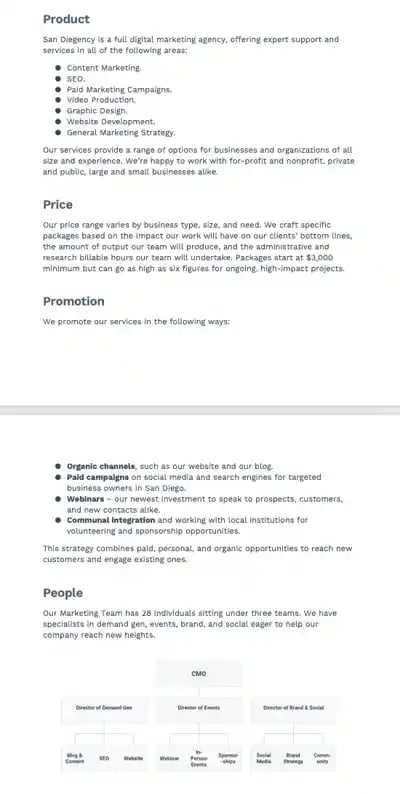
Download This Marketing Plan Outline for Free
Marketing plans can get quite granular depending on your industry and how big your digital presence is. This is true whether you're selling to consumers (B2C) or other businesses (B2B).
Despite these nuances, here are the essentials I’ve found should be present in every marketing plan or marketing planner template:
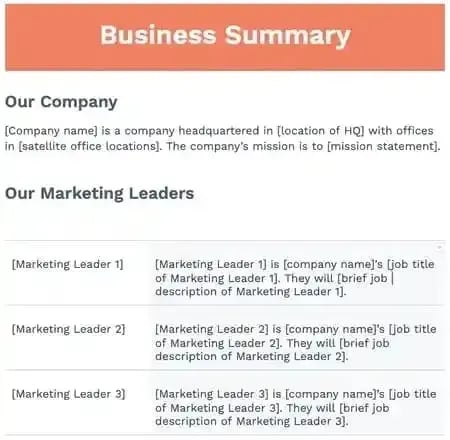
In a marketing plan, a business summary is exactly what it sounds like — a summary of the organization.
It gives all stakeholders a refresher on your company before delving into the more strategic components of your plan. It also gives them something easily accessible to refer to if they have questions during their review.
At a minimum, most business summaries include:
Our marketing plan outline also includes information on marketing leadership, which is especially helpful for companies with large marketing teams.
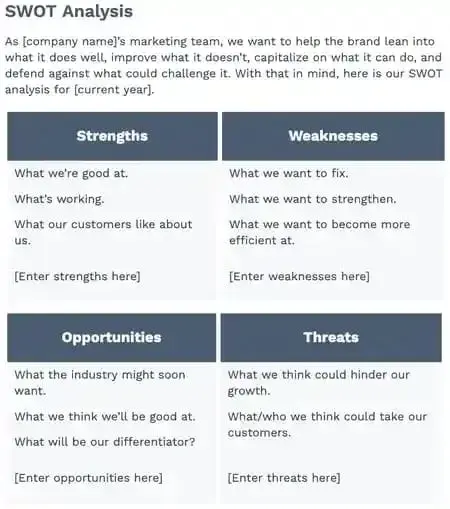
Your marketing plan's business summary should also include a SWOT analysis. This summarizes your business's strengths, weaknesses, opportunities, and threats (SWOT).
Creating a SWOT analysis is an important strategic exercise (and call me a marketing nerd, but I find it fun). It gives everyone involved a clear picture of the environment your business is working in and how it is doing within it.
It’s like a quick therapy or wellness check-up for business. You see where you’re at and perhaps even get to vent a bit before taking steps to improve things.
Including a SWOT in your marketing plan reminds readers of what circumstances are being considered in your strategy.
Pro Tip: In my experience, it’s good to have stakeholders from every section of the business contribute to creating your SWOT analysis so that nothing is overlooked.
To become truly accurate, it requires thorough market research, data analysis, and competitive analysis.
Revisit your SWOT every time you work on your marketing plan, as your audience and competition will inevitably evolve.
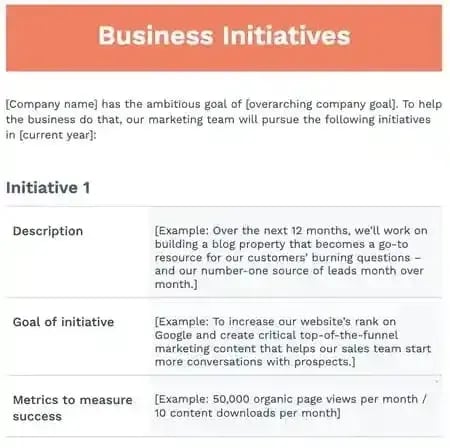
What is your marketing team working on? What do you want to work on?
Document them in your marketing plan under business initiatives. This section sets the tone for the rest of the document and its strategies.
Be careful not to get bogged down by big-picture company initiatives (i.e., opening a new location in X city or recruiting new talent via the Y platform), which you'd normally find in a business plan.
This section should outline the projects specific to marketing. You‘ll also describe those projects’ goals, which will be measured.
Every initiative should follow the SMART framework for goals — meaning they are specific, measurable, attainable, relevant, and time-bound.
For example, a broad goal might be, “Increase my Facebook following.” But a SMART version could be, “Increase my Facebook following by 30% by June.” See the difference?
Next, consider your target market, or the audience you are trying to reach with your marketing messages. This includes your industries and buyer personas.
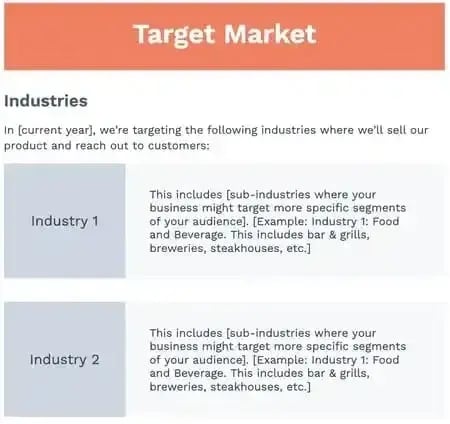
If you’re B2B, you’ll want to include a description of the industries your customers typically work in or those where your products or services are used. If you’re B2C, you can disregard this section.
Buyer Personas
A buyer persona is a semi-fictional description of your ideal customer. It focuses on traits like:
It’s a more specific characterization of your target market or the types of people you want to work with.
This section of your marketing plan should just be a brief summary of your greater buyer persona document to remind readers who your initiatives are speaking to.
Your buyer persona has choices regarding solving theirproblems, the types of solutions they consider, and the providers that canadminister those solutions.
A competitive analysis will detail the companies orbrands you’re up against, which should be considered in your marketingstrategies.
Consider who your competition is, what they do well, andwhere the gaps are that you can fill. This can include:
Our marketing plan template includes space to list thespecific products you compete with. You can also include other facets of theother company’s strategy, such as their blogging efforts or customer servicereputation.
Keep this part of your plan simple. Your full competitiveanalysis should be done separately.
Here are a few competitive analysis templates to get started.
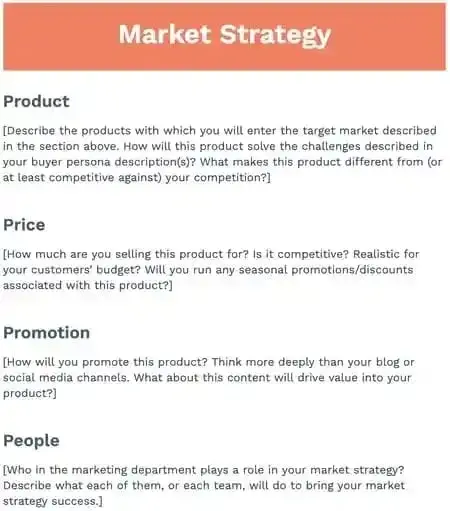
I know what you’re thinking, isn’t this whole plan ourmarketing strategy? And you’re right to a degree, but this section focuses moreon outlining what a brand needs established to go to market.
In our full-length marketing plan outline, the marketstrategy section contains the “seven Ps of marketing” (or the “extended marketing mix”):
(Note: You'll learn more about these seven sub-componentsinside our free marketing plan template, which you can download here.)
But it doesn’t simply list these details.
The market strategy in your marketing plan is where all thepieces come together. Your market strategy describes how your company shouldpresent itself in the market, keeping in mind its SWOT, competitors, consumers,and goals.
For example, if you found that one of your competitorsemploys stronger social media marketing strategies, you might add “We'llpost 3 times per week on our social media profiles” under “Promotion.”
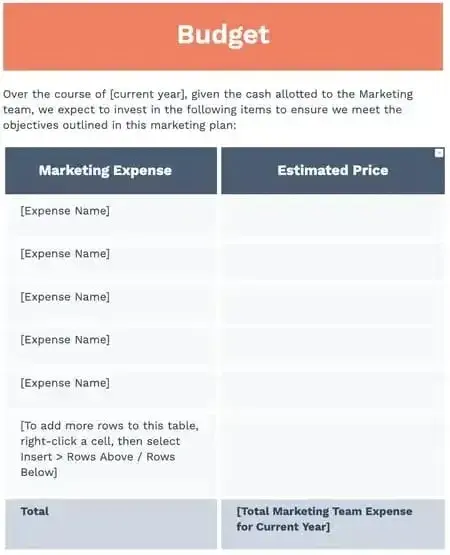
When I created my first marketing plan, I confused the marketing budget section with my product's price andother financials. That’s what “price” in your market strategy is for.
This section describes how much money the business hasallotted for the marketing team to pursue the initiatives and goals outlined inthe elements above.
Depending on how many individual expenses you have, you maywant to itemize your budget for clarity. Example marketing expenses include:
Remember, your marketing plan only includes a summary of thecosts. Keep a separate document or Excel sheet to help you calculate yourbudget much more effectively. Here’s a marketing budget template to get started.
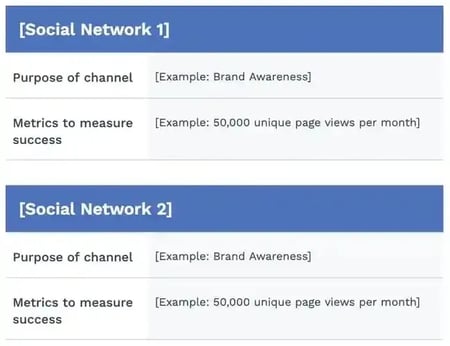
Your marketing plan should also include a list of yourmarketing channels.
While your company might sell the productusing certain ad space, your marketing channels are where you'll publish thecontent. This content educates your buyers, generates leads, and spreads brandawareness.
If you publish (or intend to publish) on social media, thisis the place to discuss it. (We’ll explore social media marketing plan templates that will helpyou get more granular a little later.)
Our template focuses on digital platforms (websites andsocial media), but you can include other mediums, such as newspapers and radioads, if necessary.
With social media as an example, use the marketing channelssection of your marketing plan to map out which social networks you want tolaunch a business page on. You should also highlight what you‘ll use thissocial network for and how you’ll measure your success.
If you also have a blog, it might be smart to leverage content marketing tools and repurpose long-formcontent into smaller social media posts. This helps drive extra traffic to yourwebsite and maximize ROI. But be sure to mention it in this section.
Part of this section's purpose is to prove to yoursuperiors, both inside and outside the marketing department, that thesechannels will serve to grow the business.
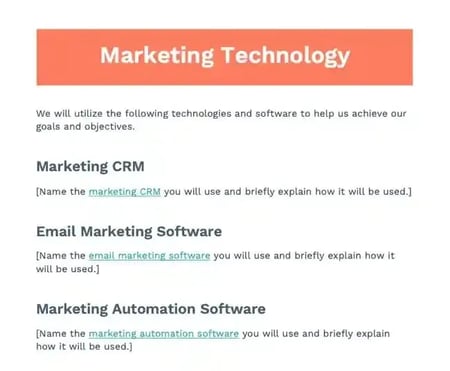
Last but certainly not least, your marketing plan shouldinclude an overview of the tools in your marketing technology (MarTech) stack.
These are the tools that help you achieve the goals yououtlined in the previous sections. Since all types of marketing software usually need a generousinvestment from your company’s leadership, connecting them to a potential ROIfor your business is essential.
For each tool, describe what you’ll use it for, and be sureit’s consistent with the strategies you’ve outlined elsewhere in your marketingplan.
For instance, we wouldn't recommend listing an advertisingmanagement tool if you didn’t list “PPC Advertising” under “Marketing Channels.” This may raiseeyebrows.
Pro tip: If you’re going for a unified marketing solution that accomplishes manygoals, still do your due diligence. Describe all of the ways you’ll use thesoftware and why it’s the best option.
When discussing marketing analytics software, specify what metrics you’lltrack with it, why those metrics are necessary, and how it will benefityour overallmarketing strategy.
Marketing Plan Timeline
Rolling out a new marketing plan is a big lift. To ensuresmooth project progress, create a timeline that maps out each project'sschedule.
A marketing plan timeline allows your team to view allprojects, campaigns, events, and other related tasks in one place — along withtheir deadlines.
This ensures everyone on your team knows what’s due when andwhat’s up next in the pipeline.
Typically, these plans cover marketing efforts for theentire year, but some companies may operate bi-annually or quarterly.
Once you’ve completed your analysis, research, and goalsetting, it’s time to set deadlines for your assignments. From new contentinitiatives to product launches, everything will need a deadline. Take intoaccount any holidays or events taking place over the course of the year.
While setting deadlines for the entire year may seemdaunting, start by estimating how long you think each task will take. Then, seta deadline accordingly. Track the time it actually takes for you to completesimilar types of projects.
Once you’ve completed a few of them, you can set moreaccurate deadlines. Looking for more tactical support? This guide breaksdown how to develop a content plan that aligns with business goals —from ideation to execution.
For each project, you’ll want to build in time for:
Pro tip: All projects and their deadlines shouldbe in a central location where your team can access them. This may be acalendar like HubSpot's tool, shared document, or project managementtool.







Discover how Workday connects your data dots, helping you make faster, smarter decisions—without the spreadsheet chaos.

Say goodbye to outdated forecasts. Workday helps you embrace continuous planning to keep your finance team fast, flexible, and future-ready.

Transform your workplace vibe. See how Workday creates meaningful employee experiences that keep your top talent loyal and thriving.

Discover how Workday's automation capabilities enhance operational efficiency by reducing manual tasks and improving accuracy across workflows.

Discover how CIOs can lead the charge in digital transformation by utilizing Workday’s cloud-based solutions to enhance agility, innovation, and data-driven decision-making.

Learn how Workday helps organizations remain agile, adapting to changing business environments with real-time solutions and flexible processes

Explore how Workday’s contract intelligence tools are transforming contract management through AI, automation, and improved collaboration..

Explore how Workday’s learning and development solutions help organizations build a future-ready workforce by promoting continuous learning, upskilling, and talent development.
Stay ahead of the tech curve! Subscribe to our weekly newsletter for a curated dose of the latest industry insights, project highlights, and exclusive updates.